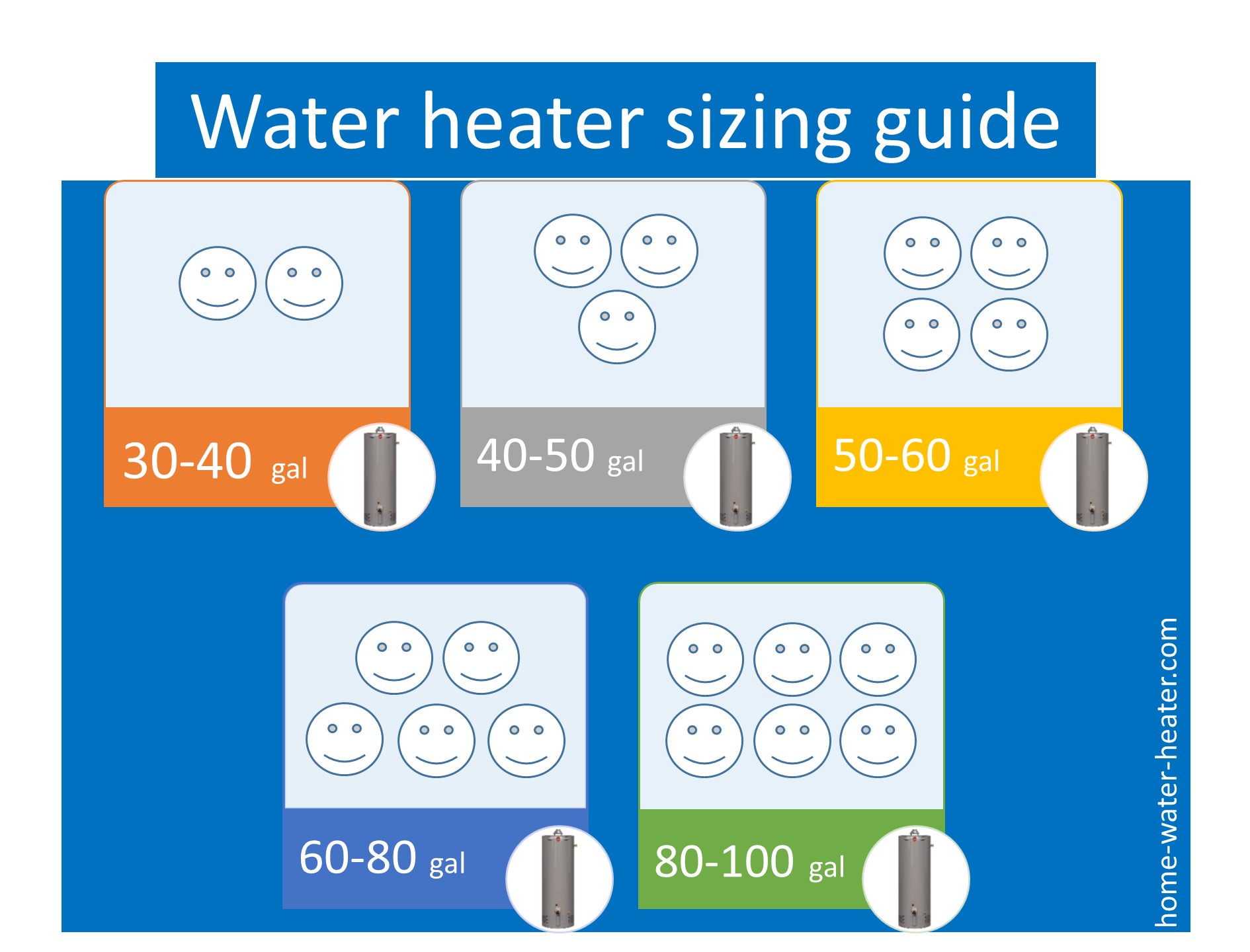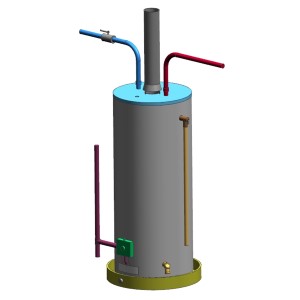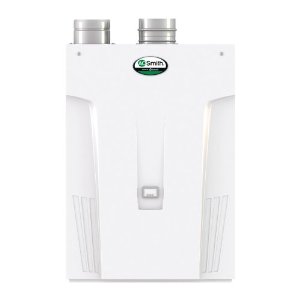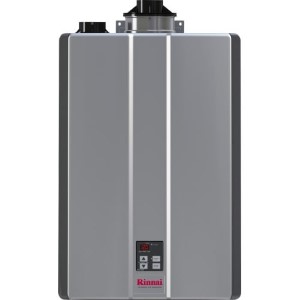- Home
- Water Tank Heater
- How to Size a Water Heater
How to Size a Water Heater -
Sizing Tips and Charts
 Sizing a water heater chart
Sizing a water heater chartBefore you buy, learn how to size a water heater and avoid frequent homeowners' mistakes. The sizing guide, tips, calculators, and a chart will help you choose the right gas- or electric-powered tank-type model, including tankless, so you can always have enough hot water for a reliable and comfortable shower.
Sizing a water heater is important because if you buy a small unit, it will run out of hot water fast, and if you buy larger than you need, you will pay more for hot water that you won't even use.
Either you are looking to buy a gas or electric water heater from Rheem, AO Smith, Bradford White, State, GE, Kenmore, or any other manufacturer, you will have a wide range of models available; from small point-of-use to high-recovery and ultra-efficiency type.
The worst thing you can do is end up with the undersized tank, which will bring only problems, such as uncomfortable showers, not enough hot water, heavy condensation, rusting or even worse - premature failure.
Highlights
- Why sizing a water heater is important
- What to consider – Sizing tips
- How to select a heater based on the heater's specs
- A table of the average consumption and peak hour demand
- Sizing a tankless
- Sizing water heater calculators
Why sizing a water heater is important
A water heater is, after home space heating, the second-largest energy consumer, and with the rising costs of energy, water heating could impact your budget significantly. Before you buy a new unit, you have to think of the operating costs, and not only the costs of the fuel and heater.
One of the most frequent questions I received, and also found in many reviews are "the heater is not producing enough hot water" or "there is no hot water after 15 minutes of using it".
The above concerns should be taken into account (I mean seriously) when buying a new unit. And this is the reason why we have this article and why you are here... to learn to size a water heater accurately so you won't spend more or deal with the cold baths and unfinished laundry.
What to consider when sizing a tank-type water heater?

Before you learn how to size a water heater for a family of 3, 4, 5, or more, a small house with 1 or 2 bathrooms, or a large house with 3+ bathrooms, make sure to get answers to the following questions:
- What is the number of people who live in the household? How many kids and teenagers? Teenagers usually have a habit of using lots of hot water. It is also important to factor in any frequent guests you have or plan to have and their overnight stays (grandparents, for example).
- How many plumbing fixtures there are in a home, including dishwashers, clothes washers, especially large tubs, whirlpools, and such.
- How many showers would be used at the same time?
- What is the largest bathtub?
Tip: If you have a whirlpool tub, the tank capacity should be the same or higher.
- What is the pattern of hot water usage? When it is used the most; is it early morning before work and school, the evening before bed, or any other time?
- What is the incoming (ground) water temperature? The groundwater temperature depends on the location, elevation, and time of the year (climate).
- You can use a map to determine an average temperature in your area.
- Location is also important as the ground or incoming (inlet) water, for example, is colder in northern regions than in southern.
As seen from the above, it is important to investigate the hot water usage pattern and habits of the family members at home. It is vital to know what part of the day is when the high demand for hot water occurs.
For example, in many households, the highest demand for hot water occurs between 9 and 11 PM when most of the family members are taking two or more simultaneous showers and when the washing machine and dishwasher are running simultaneously.
- Find Plumbers In Your Area -
How to size a water heater and select the right model based on the product specifications
When checking for heaters, you will notice some important data in the specifications provided by the manufacturer: Power, Efficiency, Peak Hour Demand, First Hour Delivery, and Recovery Rate. As you analyze the technical data, you become more familiar with the available models and how to size a water heater properly.
The power or input is the amount of electricity (in Watts) or gas (in BTU) used in one hour for water heating. Choosing a water heater with higher input results in faster healing.
The Peak Hour Delivery shows the highest amount of hot water (in gallons per hour - GPH) delivered by a water heater during the busiest time.
The First Hour Rate is calculated as the maximum volume of hot water delivered during the first hour of heating.
The Recovery Rate is the amount of water (in gallons per hour) one heater can raise when the temperature increases by 60 F. As it is a part of the First Hour Rating, it can also be defined as the capacity of the heater to produce hot water in one hour.
When you compare electric vs. gas units, gas models have the higher First Hour Delivery, so its tank can be smaller than the electric ones while producing the same amount of hot water. Keep in mind that only 70% of the hot water of the heater's tank size is actually available for use (50-gallon tank size has 35 gallons of hot water for use).
Table of the average consumption and peak hour demand
This calculation is based on the family size of 4:
| Application | Average consumption (gallons) |
Peak time usage (in one hour period) |
Used Hot Water (gal.) |
| Shower | 20 | 4 | 80 |
| Automatic Dishwasher |
14 | ||
| Clothes washer | 32 | ||
| Hand dishwashing | 4 | 1 | 4 |
| Shave | 2 | 1 | 2 |
| Food preparation | 4 | 1 | 4 |
| House cleaning | 6 | ||
| Hand washing | 2 | ||
| Hot water demand in the peak time (gal.) | 90 | ||
Water heater sizing chart as per manufacturers' recommendations
| Family size (# of people) | Peak demand (gallons) regular/high demand |
| 2 | 45-55 |
| 3 | 55-65 |
| 4 | 65-75 |
| 5 | 75-85 |
| 6 | 85-100 |
| 7 | 100 or more |
Every water heater comes with the Energy Guide label that shows the Peak Hour Demand capacity, also known as the First Hour Rating (FHR). If you are in a store and didn't have time to learn how to size a water heater, you can use the FHR value instead – higher is better.
Sometimes, instead of one large unit, it is worth considering getting a water heater with smaller tanks and higher recovery rates. If large amounts of hot water are required, you can install multiple units plumbed in parallel.
Sizing a tankless water heater

Tankless water heaters, as opposed to tank-type models, do not store hot water inside the tank. They use the heat exchanger where water, while passing, is heated - on demand.
This is why we use a different approach when sizing and trying to answer the question: "how big a water heater do I need".
The following should be considered:
What is the flow rate (in GPM)? For example, if you want to run two fixtures at the same time, one with a flow rate of 0.5 GPM and the other of 1 GPM, the tankless water heater should provide at least 1.5 GPM.
What is the number of fixtures you want to use simultaneously?
What is the flow rate of each device and the total volume? Add up the flow rates of all the devices you want to run simultaneously.
What is the temperature rise? Figure out the temperature rise by subtracting the temperature of incoming and outgoing water. Keep in mind that the temperature of incoming water varies by region and climate. (Example: If the temperature of the incoming water is 50 F and you want to get hot water with the temperature of 120 F (outgoing), the temperature rise is 120-50=70 F. Most of the manufacturers will provide a table or graph showing a variety of water flows in relation to different temperature rise.
Tip: Use this map to get the temperature of groundwater temperature in your region.
- Bathroom 0.5-1.5 GPM
- Kitchen 1.5 GPM
- Shower 1-2 GPM
- Dishwasher 1.5 GPM
- Clothes washer 2 GPM
- Tub 4 GPM
Sizing tools and calculators
Conclusion
All the tips for sizing the water heater from the above text are helpful for the homeowners who are buying a new or replacing the old heater. Always consider your future family needs for hot water, so buying a larger tank size is a good idea if running out of hot water often, your family grows or planning to add some new fixtures.
When sizing tank-type water heaters, the main criteria are the tank capacity and recovery rate (in gallons per hour – GPH), while for tankless is the hot water flow rate (in gallons per minute – GPM).
Related
- Home
- Water Tank Heater
- How to Size a Water Heater



